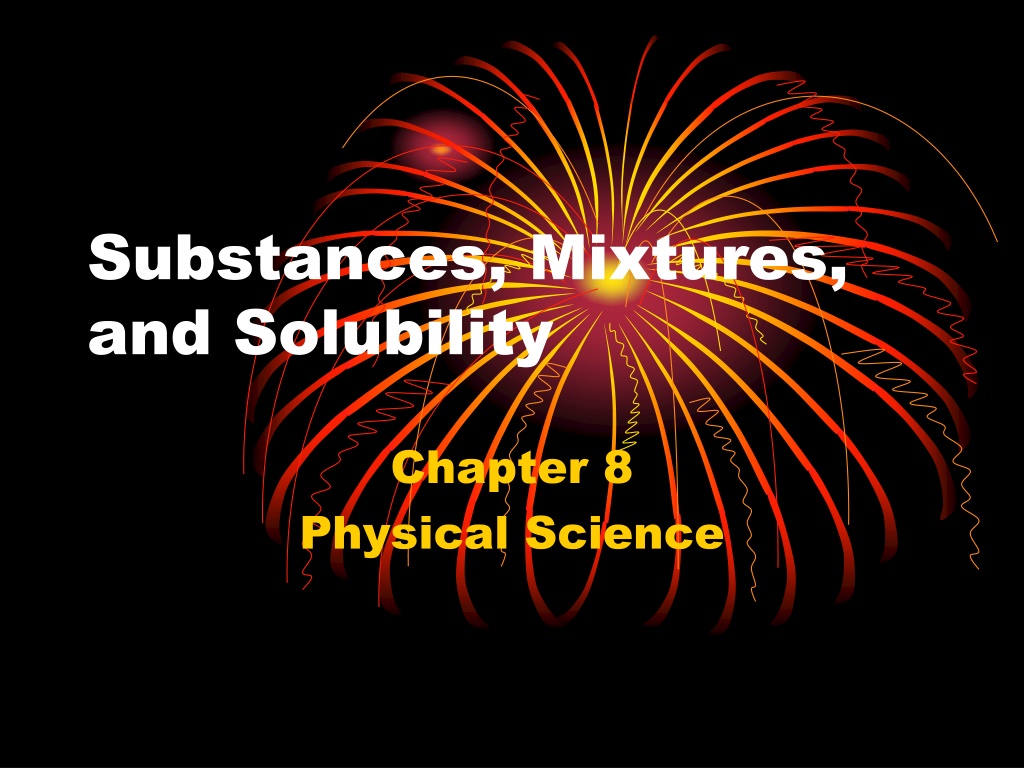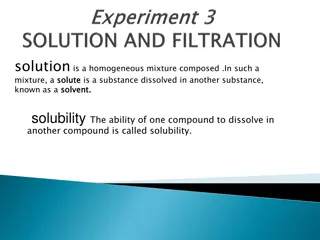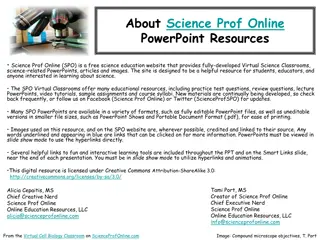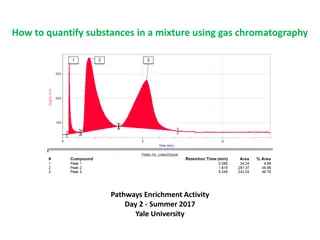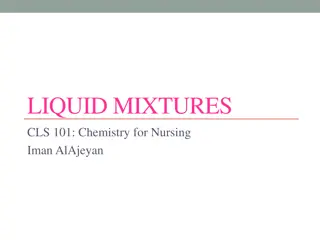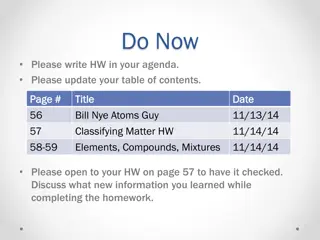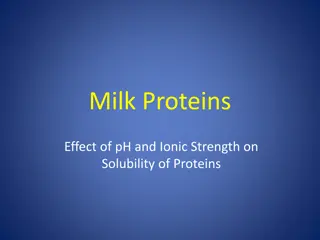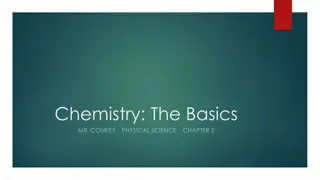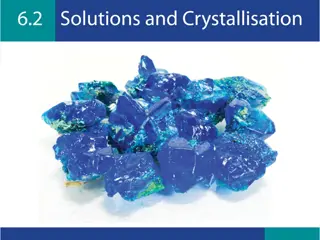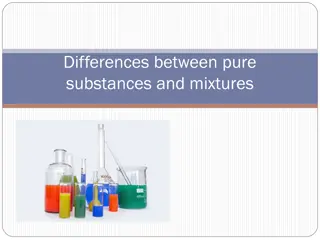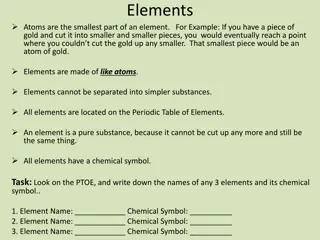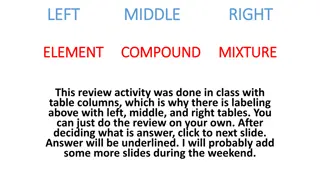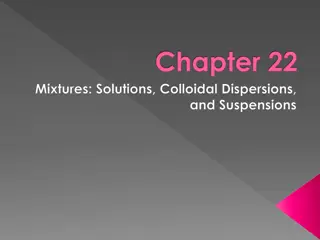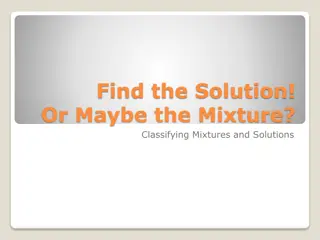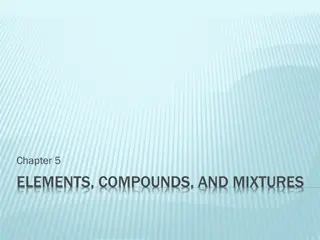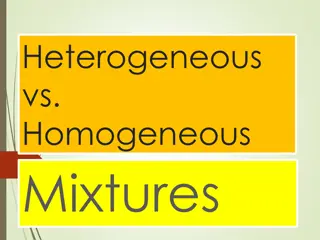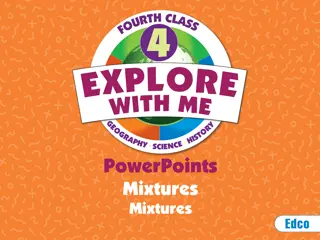Understanding Substances, Mixtures, and Solubility in Physical Science
Explore the concepts of substances, mixtures, and solubility in Physical Science with a detailed explanation of solutions, types of mixtures, and the importance of understanding these in everyday life. Discover the differences between atoms, elements, pure substances, and mixtures, and learn about homogeneous and heterogeneous mixtures. Gain insights into how compounds are formed and the properties of pure substances versus mixtures.
Download Presentation

Please find below an Image/Link to download the presentation.
The content on the website is provided AS IS for your information and personal use only. It may not be sold, licensed, or shared on other websites without obtaining consent from the author. Download presentation by click this link. If you encounter any issues during the download, it is possible that the publisher has removed the file from their server.
E N D
Presentation Transcript
Substances, Mixtures, and Solubility Chapter 8 Physical Science
8.1 What is a Solution? Objectives: Objectives: 1. Distinguish between substances and mixtures. 2. Describe two different types of mixtures. 3. Explain how solutions form. 4. Describe different types of solutions.
Why its important to you! The air you breathe, the water you drink, and even parts of your body are all solutions.
Substances We see differences in everything around us Water Orange juice Salt water Chemistry explains how these are different and how they are connected.
Atoms & Elements Atoms basic building block of ALL matter Atoms of one kind make up the elements Atoms chemically combine to make substances like compounds
Pure Substances Element is pure One type of atom only Compound is pure Two or more elements chemically combined to form a new matter that is pure Has the same ratio of elements always Has new set of properties unlike those of the elements that make it up
Mixture Combination of substances that are not bonded together How do you know? Each substance retains its own properties So you will taste the salt in a salt water mixture.
Unlike compounds, mixtures do not keep the same proportions of substances that make them up A mixture may taste really sweet or not so sweet depending on the amount of sugar added to the mixture
Kinds of Mixtures Homogeneous Heterogeneous
Homogeneous Mixture Contains two or more substances Evenly mixed on a molecular level NOT bonded together Examples pop, kool-aid, popsicle Another name is a solution
Heterogeneous Mixture Two or more substances unevenly mixed One particle typically larger than the other Examples seeds in a watermelon, bowl of cold cereal in milk, jello
How Solutions Form Solute substance dissolving (smaller amount) Solvent substance does dissolving (larger amount)
Solutions of many kinds Solutes can fall out of a solution Process of crystallization In a chemical reaction, a solid can form between two solutions this solid is a precipitate Example - minerals (soap scum) in your sink when soap and water combine
Formed from solutions Stalactites (cave roof) Stalagmites (cave floors) Formed when a solution of minerals drips in the cave and the liquid evaporates leaving the mineral behind
Types of Solutions Solutions come in many forms Gas/ gas solutions (air) Gas/ Liquid solutions (pop) Solid/ solid solutions (solder) Liquid/ solid solutions (apple juice)
Solid / Solid solutions can make solder for welding or statues Remember that the two solids would need to be heated and mixed before allowing them to cool into the solid solution they will form
Test YourSelf How are substances and mixtures different? What are the two types of mixtures? How do you form a solution? Describe different types of solutions.
8.2 Solubility Objectives 1. Explain why water is a good general solvent. 2. Describe how the structure of a compound affects which solvents it dissolves in. 3. Describe how temperature affects the reaction rate. 4. Explain how solute particles affect physical properties of water.
Why its important How you wash your hands, clothes, and dishes depends on which substances can dissolve in other substances. It is important to understand why this happens.
Water the Universal Solvent Since many substances dissolve in water, it is called the universal solvent All chemical reactions in your cells take place in a water environment so this is an important fact
Molecular Compounds Happen when atoms share electrons This forms a covalent bond Sometimes the electron sharing is not equal
Molecular Compound Bonds Polar the electrons are unevenly shared so one element keeps them closer to its nucleus than the other Water is an example Nonpolar electrons are evenly shared between the atoms
Polar Bond Notice the electrons are closer to the oxygen than the hydrogen. This gives a positive end (Hydrogen) and a negative end (Oxygen)
Nonpolar Bond Sugar Methane Since the electrons move evenly between both atoms https://www.google.com/search?q=nonpolar+bond+methane+image&tbm=isch&source=iu&imgil=O3WkTPLzPPNQOM%253A%253Bhttps%253A%252F%252Fencrypted- tbn0.gstatic.com%252Fimages%253Fq%253Dtbn%253AANd9GcQ7GXcBK0PUJGzMGhHjanvRPiDX49lpVJwqvXBt8diVTh_co37IeQ%253B284%253B211%253BX7tXIgoMhCqHvM%253Bhttp%25253A%25252F% 25252Ffaculty.clintoncc.suny.edu%25252Ffaculty%25252Fmichael.gregory%25252Ffiles%25252Fbio%2525252520101%25252Fbio%2525252520101%2525252520lectures%25252Fbiochemistry%25252Fbioc hemi.htm&sa=X&ei=NM7OUseXHo7foASW9YCwDA&ved=0CDYQ9QEwBQ&biw=1024&bih=569#facrc=_&imgdii=_&imgrc=O3WkTPLzPPNQOM%253A%3BX7tXIgoMhCqHvM%3Bhttp%253A%252F%252Ffaculty .clintoncc.suny.edu%252Ffaculty%252Fmichael.gregory%252Ffiles%252Fbio%25252520101%252Fbio%25252520101%25252520lectures%252Fbiochemistry%252Fmethane.gif%3Bhttp%253A%252F%252Ffa culty.clintoncc.suny.edu%252Ffaculty%252Fmichael.gregory%252Ffiles%252Fbio%252520101%252Fbio%252520101%252520lectures%252Fbiochemistry%252Fbiochemi.htm%3B284%3B211
Ionic Bonds Some atoms exchange electrons Happens between a metal and nonmetal This electron exchange causes an atom to have an uneven number of protons and electrons creating ions
Ions Notice the loss of one electron creates a 1+ ion https://www.google.com/search?q=nonpolar+bond+methane+image&tbm=isch&source=iu&imgil=O3WkTPLzPPNQOM%253A%253Bhttps%253A%252F%252Fencrypted- tbn0.gstatic.com%252Fimages%253Fq%253Dtbn%253AANd9GcQ7GXcBK0PUJGzMGhHjanvRPiDX49lpVJwqvXBt8diVTh_co37IeQ%253B284%253B211%253BX7tXIgoMhCqHvM%253Bhttp%25253A%25252F%252 52Ffaculty.clintoncc.suny.edu%25252Ffaculty%25252Fmichael.gregory%25252Ffiles%25252Fbio%2525252520101%25252Fbio%2525252520101%2525252520lectures%25252Fbiochemistry%25252Fbiochemi.h tm&sa=X&ei=NM7OUseXHo7foASW9YCwDA&ved=0CDYQ9QEwBQ&biw=1024&bih=569#q=ion+image&tbm=isch&facrc=_&imgdii=_&imgrc=guBRd1a4VDXQGM%253A%3B4zv1jbRwGg25yM%3Bhttp%253A%252F %252Fwww.gcsescience.com%252FSodium-Atom-Sodium-Ion.gif%3Bhttp%253A%252F%252Fwww.gcsescience.com%252Fa4-sodium-ion.htm%3B396%3B198
Dissolving Ionic Compounds Each ion is surrounded by the water molecules Notice the positive Hydrogen end surrounds The negative Chlorine ion And the positive Oxygen End surrounds the Na+ http://www.shs.d211.org/science/faculty/S2B/Old%20Stuff/water_dissolving_an _ionic_compou.htm
Dissolving Covalent Compounds Notice the Entire sugar Molecule gets Surrounded Instead of parts Of the sugar molecule
What Will Dissolve? Like Dissolves Like Molecules of similar chemistry will dissolve others like themselves This is why oil and water will not dissolve in one another
Solubility Describes how much solute will dissolve in a solvent This is described as 60 g of sugar will dissolve in 100 g of water. 100 g of water = 100 mL
Solubility Some solutes are highly soluble Some are not Usually increasing the heat increases solubility Remember our rate of reaction lab?
Insoluble When a substance like barium sulfate has an extremely low solubility, we refer to it as being insoluble This image Illustrates oil And water
Solubility Curves The steeper the line, the More soluble The substance
Liquid-Solid Solutions Temperature makes a difference Increased temperature increases the solubility Sodium chloride and calcium carbonate do not become more soluble with higher temperatures they remain constant
Liquid-Gas Solutions An increase in temperature decreases the solubility of a gas in a liquid- gas solution Carbon dioxide is less soluble at lower temperatures
Saturated Solutions This indicates all the spaces available in a solvent are filled by molecules of solute No more solute can be held by the solvent unless we add heat
Unsaturated Solution More Solute can be added to the solvent without adding any energy
Rate of Dissolving If the molecules move faster the dissolving rate will increase Ways to move the molecules faster include: Heat Stirring Lower concentration Greater surface area
Concentration The amount of solute in a solvent Concentrated = full of solute Dilute = room is available for the solute to fill spaces in the solvent
Measuring Concentration 2 g of glucose in 100 mL of water 2g 100mL =.02 or 2% solution
Effects of Solute Particles When adding a solute to a solvent if affects the melting point and boiling point of the solvent
Effects of Solute Adding solute to water when freezing the water changes how the water molecule arrange while trying to form crystals To overcome this interference the temperature must get lower to freeze the solvent This is why salt is placed on icy walkways
Boiling with a Solute When water boils, each molecule of solvent gains enough energy to change states Solutes in the water will disrupt this energy absorption so MORE energy is needed to boil the water the boiling point will be higher
Review How does adding a solute to a solution change its boiling point?
The boiling point is elevated because it takes more energy to get each of the solvent molecules to energy level needed to escape the liquid phase and turn into a gas
A ___________ changes color to identify the hydronium ion concentration and determine if there is an acid or base present.
8.3 Acidic & Basic Solutions What You ll Learn Compare acids and bases and their properties Describe practical uses of acids and bases Explain how pH is used to describe the strength of an acid or base Describe how acids and bases react when they are brought together
Why its important? Many common products, such as batteries and bleach, work because of acids and bases. Since we use these products daily, we need to understand them.
Acids Are substances that release positively charged hydrogen ions in the water Hydrogen ions are represented as H+
